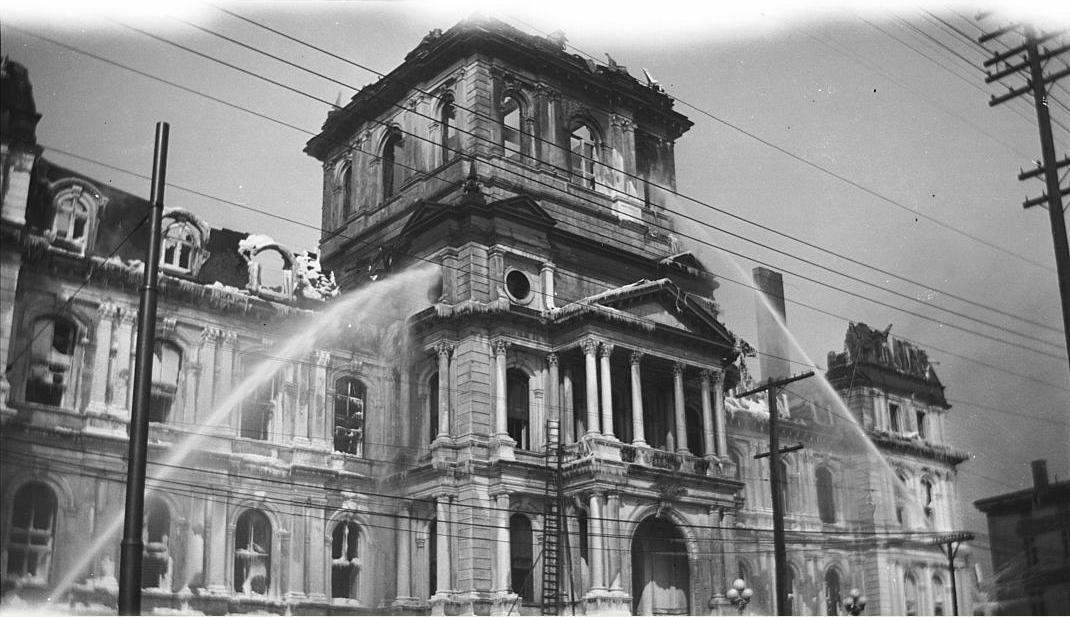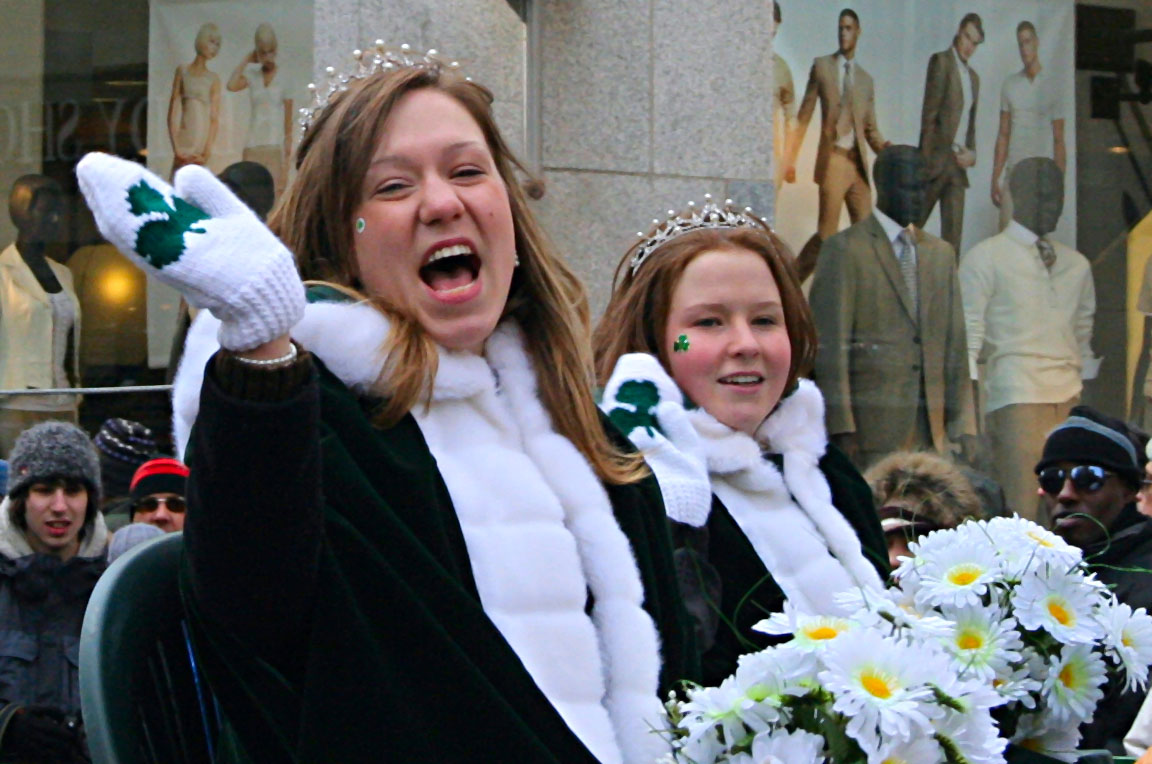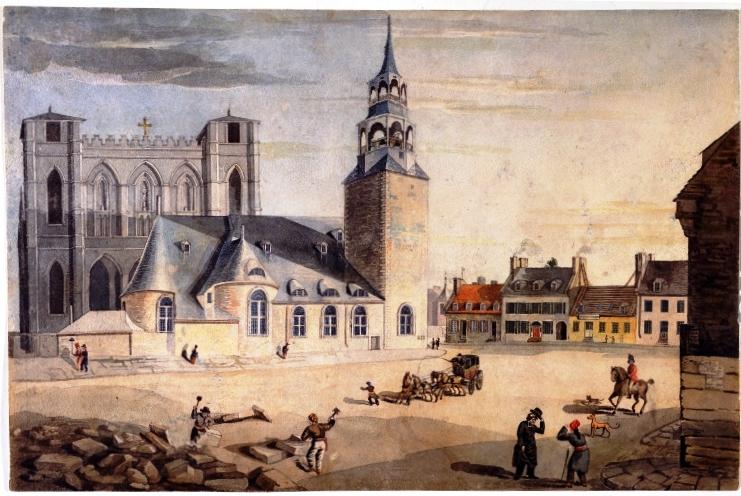|
Rue Notre-Dame
Notre-Dame Street (officially in ) is a historic east–west street located in Montreal, Quebec, Canada. It runs parallel to the Saint Lawrence River, from Lachine to the eastern tip of the island in Pointe-aux-Trembles, then continuing off the island into the Lanaudière region. One of the oldest streets in Montreal, Notre-Dame was created in 1672. The gardens of Château Vaudreuil, which had served as the official residence in Montreal of the Governors General of New France from 1723, fronted Notre-Dame. The street's extension in 1821 led to the demolition of Montreal's Citadel. The Bingham house, which became Donegana's Hotel, was also located on Notre-Dame. In the early 1900s, it was the site of the former Dominion Park. Old Montreal and beyond In Old Montreal, it is the site of such key structures as Montreal City Hall, Palais de Justice de Montréal, the Quebec Court of Appeal, the Château Ramezay, Notre-Dame Basilica and the Saint-Sulpice Seminary and the Sir ... [...More Info...] [...Related Items...] OR: [Wikipedia] [Google] [Baidu] |
Montreal City Hall
The five-story Montreal City Hall (, ) is the seat of local government in Montreal, Quebec, Canada. It was designed by architects Henri-Maurice Perrault and Alexander Cowper Hutchison, and built between 1872 and 1878 in the Second Empire (architecture), Second Empire style. It is located in Old Montreal, between Place Jacques-Cartier and the Champ de Mars, Montreal, Champ de Mars, at 275 Notre-Dame Street East. The closest Montreal Metro, Metro station is Champ-de-Mars station (Montreal Metro), Champ-de-Mars, on the Orange Line (Montreal Metro), Orange Line. As one of the best examples of the Second Empire (architecture), Second Empire style in Canada, and the first Seat of local government, city hall to have been constructed in the country solely for municipal administration, it was designated a National Historic Sites of Canada, National Historic Site of Canada in 1984. History and architecture Construction on the building began in 1872 and was completed in 1878. The original ... [...More Info...] [...Related Items...] OR: [Wikipedia] [Google] [Baidu] |
Dominion Park
Dominion Park was an amusement park in Montreal, Quebec, Canada, situated between Notre-Dame Street (near Haig Avenue) and the Saint Lawrence River in the early twentieth century. The park opened on June 2, 1906 and was shuttered in 1937, surviving two fires, in 1913 and 1919. It was owned by the Montreal Suburban Tramway and Power company. See also *Belmont Park, Montreal External links Closed Canadians Parks Web site Defunct amusement parks in Canada History of Montreal Culture of Montreal 1906 establishment ... [...More Info...] [...Related Items...] OR: [Wikipedia] [Google] [Baidu] |
Burning Of The Parliament Buildings In Montreal
The burning of the Parliament Buildings in Montreal occurred on the night of April 25, 1849, in Montreal, the then-capital of the Province of Canada. The way the matter was handled by then co-prime ministers of the united Province of Canada, Sir Louis-Hippolyte Lafontaine and Robert Baldwin, helped develop the Canadian democratic tradition. It also caused the capital to be moved elsewhere, eventually being installed in Ottawa. Tories protesting against the Rebellion Losses Bill burned down the St. Anne's Market building lodging the Legislative Council and Assembly of Canada while the members of the Legislative Assembly were sitting in session within. Similar protests, such as the Stony Monday riot, occurred in many places across British North America against the bill. The episode exemplified the divisions in pre-Confederation Canadian society concerning whether Canada was the North American appendage of the British Empire or a nascent sovereign nation where citizens cou ... [...More Info...] [...Related Items...] OR: [Wikipedia] [Google] [Baidu] |
Benjamin D'Urban
Lieutenant-general (United Kingdom), Lieutenant General Sir Benjamin D'Urban (16 February 1777 – 25 May 1849) was a British General officer, general and colonial Administrator of the Government, administrator, who is best known for his frontier policy when he was the Governor in the British Cape Colony, Cape Colony (now in South Africa). Durban (formerly called Port Natal), the third-largest city in South Africa, was renamed in his honor. Early career D'Urban was born in Halesworth, the youngest but only surviving son of Benjamin D'Urban, and joined the British Army in 1793, enlisting as a Cornet (military rank), cornet in the 2nd Dragoon Guards (Queen's Bays), Queen's Bays at the age of sixteen. He made rapid progress in the Army and distinguished himself in the Peninsular War. Assigned to the Portuguese army, he was quartermaster general and chief-of-staff to William Beresford, 1st Viscount Beresford, William Carr Beresford, 1st Viscount Beresford. He served in all the p ... [...More Info...] [...Related Items...] OR: [Wikipedia] [Google] [Baidu] |
Joe Beef (restaurant)
Joe Beef is a restaurant in Montreal, Quebec, Canada. The owners describe the cuisine as “Bocusian-Lyonnaise cuisine du marché (French market cuisine).” It is located in the neighbourhood of Little Burgundy, in the borough of Le Sud Ouest. History Joe Beef was opened on September 19, 2005 by David McMillan, Frederic Morin, and Allison Cunningham with financial guidance and investment by Jeff Baikowitz and David Lisbona. The restaurant took over the location of Café Miguel. The restaurant's name is a homage to Montreal's infamous Joe Beef, an alias for Charles McKiernan. McKiernan, who owned a tavern that served many lower-class laborers in Montreal, "died in his canteen of a heart attack at the age of 54." McKiernan's generosity and gluttony may have inspired the concept of Joe Beef restaurant, which challenges the conventions of fine French dining. As of November 25th, 2021 co-founder David McMillan announced his retirement, citing burnout and stress after 32 years in t ... [...More Info...] [...Related Items...] OR: [Wikipedia] [Google] [Baidu] |
Black Canadians
Black Canadians () are Canadians of full or partial Afro-Caribbean or sub-Saharan African descent. Black Canadian settlement and immigration patterns can be categorized into two distinct groups. The majority of Black Canadians are descendants of immigrants from the Caribbean and the African continent who arrived in Canada during significant migration waves, beginning in the post-war era of the 1950s and continuing into recent decades. A smaller yet historically significant population includes the descendants of African Americans, including fugitive slaves, Black loyalists and refugees from the War of 1812. Their descendants primarily settled in Nova Scotia and Southern Ontario, where they formed distinctive identities such as Black Ontarians and African Nova Scotians. Black Canadians have contributed to many areas of Canadian culture. Many of the first visible minorities to hold high public offices have been Black, including Michaëlle Jean, Donald Oliver, Stanley G. ... [...More Info...] [...Related Items...] OR: [Wikipedia] [Google] [Baidu] |
English-speaking Quebecer
English-speaking Quebecers, also known as Anglo-Quebecers, English Quebecers, or Anglophone Quebecers (all alternately spelt Quebeckers; in French ''Anglo-Québécois'', ''Québécois Anglophone'') or simply Anglos in a Quebec context, are a linguistic minority in the Francophonic province of Quebec. According to the 2011 Canadian census, 599,225 people (around 7.7% of the population) in Quebec declare English as a mother tongue. When asked, 834,950 people (about 10.7% of the population) reported using English the most at home. The origins of English-speaking Quebecers include immigration from both English-speaking and non English-speaking countries, migration from other Canadian provinces, and strong English language education programs in Quebecois schools. This makes estimating the population of those who identify as English-speaking Quebecers difficult. Population Statistics Canada uses census data to keep track of minority language communities in Canada. It has re ... [...More Info...] [...Related Items...] OR: [Wikipedia] [Google] [Baidu] |
Little Burgundy
Little Burgundy (, ) is a neighbourhood in the Le Sud-Ouest, South West Boroughs of Montreal, borough of the city of Montreal, Quebec, Canada. Geography Its approximate boundaries are Atwater Avenue to the west, Saint Antoine Street, Saint-Antoine to the north, Guy Street to the east, and the Lachine Canal to the south. The adjacent neighbourhoods are the borough of Ville-Marie (Montreal), Ville-Marie and downtown Montreal to the north and northeast, Griffintown to the southeast, Pointe-Saint-Charles to the south, and Saint-Henri to the west. The neighbourhood comprises the former city of Sainte-Cunégonde and Saint-Joseph's ward. Origin There are differing accounts of the origin of the name Little Burgundy (''Petite-Bourgogne''). A surveyor's map of 1855 identifies a property called Bourgogne, owned by the heirs of the Hon. Louis Guy (brother of Étienne Guy, for whom Guy Street was named). The property corresponds to the areas bounded today by Rue des Seigneurs, Rue Notre- ... [...More Info...] [...Related Items...] OR: [Wikipedia] [Google] [Baidu] |
École De Technologie Supérieure
École de technologie supérieure (, ''Higher Technology School'', ÉTS), founded in 1974, is a public university, public research university in Montreal, Montreal, Quebec, Canada and affiliated to the Université du Québec system. The school specializes in applied teaching and research in engineering as well as Technology transfer, transferring advanced technologies to companies. In any given year, 25% of all engineers receiving a diploma from an engineering school or faculty in the province of Quebec graduate from the ÉTS. The school ranks second in Canada for the number of bachelor's degrees in engineering awarded at the undergraduate level. History ÉTS opened in 1974 on Rue Sainte-Catherine, in Montreal, and received 28 undergraduate students in technology (mechanics and electricity). The ÉTS Student Association (AEETS) was created the following year. In 1977, the diploma (B. Tech.) was awarded to the first 14 graduates. Bachelor's degrees in construction technol ... [...More Info...] [...Related Items...] OR: [Wikipedia] [Google] [Baidu] |
Sir George-Étienne Cartier National Historic Site
The Sir George-Étienne Cartier National Historic Site is a historic house museum located in the Old Montreal district, of Montreal, Quebec, Canada. It commemorates the life and accomplishments of Sir George-Étienne Cartier. This reconstitution of the adjoining homes of the Cartier family features the architectural heritage left by the upper middle class of 19th-century Montreal, along with interpretive activities and theatrical performances. It was designated a National Historic Site of Canada National Historic Sites of Canada () are places that have been designated by the federal Minister of the Environment on the advice of the Historic Sites and Monuments Board of Canada (HSMBC), as being of national historic significance. Parks C ... in 1964. References External links * Old Montreal George-Étienne Cartier Historic house museums in Quebec Museums in Montreal National Historic Sites in Quebec Houses in Montreal Cartier {{Canada-museum-stub ... [...More Info...] [...Related Items...] OR: [Wikipedia] [Google] [Baidu] |
Saint-Sulpice Seminary (Montreal)
The Saint-Sulpice Seminary () is a building in Montreal, Quebec, Canada. It is the second oldest structure in Montreal and was declared a National Historic Site of Canada in 1980. It is located in the Ville-Marie Borough in the Old Montreal district, next to Notre-Dame Basilica on Notre-Dame Street, facing Place d'Armes. The seminary is a classic U-shaped building featuring a palatial style and includes an annex. Saint-Sulpice Seminary was founded in 1657 by the Society of Priests of Saint Sulpice, who have been the sole owner of the building since its creation. Construction began in 1684 by François Dollier de Casson, superior of the Sulpicians, and was completed in 1687, although later additions, such as the clock, were completed by 1713. It was dedicated to the education of secular priests and to mission work among native peoples in New France New France (, ) was the territory colonized by Kingdom of France, France in North America, beginning with the exploratio ... [...More Info...] [...Related Items...] OR: [Wikipedia] [Google] [Baidu] |
Notre-Dame Basilica (Montreal)
Notre-Dame Basilica of Montreal ( French: ''Basilique Notre-Dame de Montréal'') is a minor basilica of the Catholic Church in the historic Old Montreal district of Montreal in Quebec, Canada. It is located at 110 Notre-Dame Street West, at the corner of Saint Sulpice Street. It is situated next to the Saint-Sulpice Seminary and faces the Place d'Armes square. The interior of the church is amongst the most dramatic in the world and regarded as a masterpiece of Gothic Revival architecture. The vaults are coloured deep blue and decorated with golden stars, and the rest of the sanctuary is decorated in blues, azures, reds, purples, silver, and gold. It is filled with hundreds of intricate wooden carvings and several religious statues. Unusual for a church, the stained glass windows along the walls of the sanctuary do not depict biblical scenes, but rather scenes from the religious history of Montreal. It also has a Casavant Frères pipe organ, dated 1891, which comprises four k ... [...More Info...] [...Related Items...] OR: [Wikipedia] [Google] [Baidu] |








